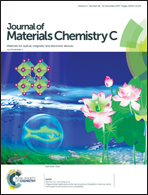Insights into excellent persistent luminescence and detecting trap distribution in BaHfSi3O9:Eu2+,Pr3+†
Abstract
A barizite-like compound BaHfSi3O9 (BHS) was tailored to emit intense bluish green persistent luminescence (PersL) above the recognizable intensity level (≥0.32 mcd m−2) lasting for more than 12 h through codoping with Eu2+ and Pr3+. X-ray powder diffraction, the crystal and electronic structures, photoluminescence (PL) and photoluminescence excitation (PLE) were basically studied. Furthermore, decay curves, as well as thermo-luminescence (TL) spectra, were systematically carried out to clarify the mechanism of the PersL. We used the excitation duration, decay duration and excitation temperature dependent TL experiments to estimate the trap density distribution in BHS:Eu2+,Pr3+ phosphor. Based on the above measurements, the  positive defects could be responsible for the bluish green PersL at room temperature. In the process of PersL, the electrons captured by shallow traps transfer to the Eu2+ levels through a conduction band (CB) which leads to a rapid decay in the early decay stage (t < 3 h), whereas the electrons trapped by deep traps through a quantum tunnelling process result in much slower and nonexponential decay behavior in the later slow-decay stage (t > 3 h). A possible mechanism is proposed for the PersL process in BHS:Eu2+,Pr3+ phosphor.
positive defects could be responsible for the bluish green PersL at room temperature. In the process of PersL, the electrons captured by shallow traps transfer to the Eu2+ levels through a conduction band (CB) which leads to a rapid decay in the early decay stage (t < 3 h), whereas the electrons trapped by deep traps through a quantum tunnelling process result in much slower and nonexponential decay behavior in the later slow-decay stage (t > 3 h). A possible mechanism is proposed for the PersL process in BHS:Eu2+,Pr3+ phosphor.



 Please wait while we load your content...
Please wait while we load your content...